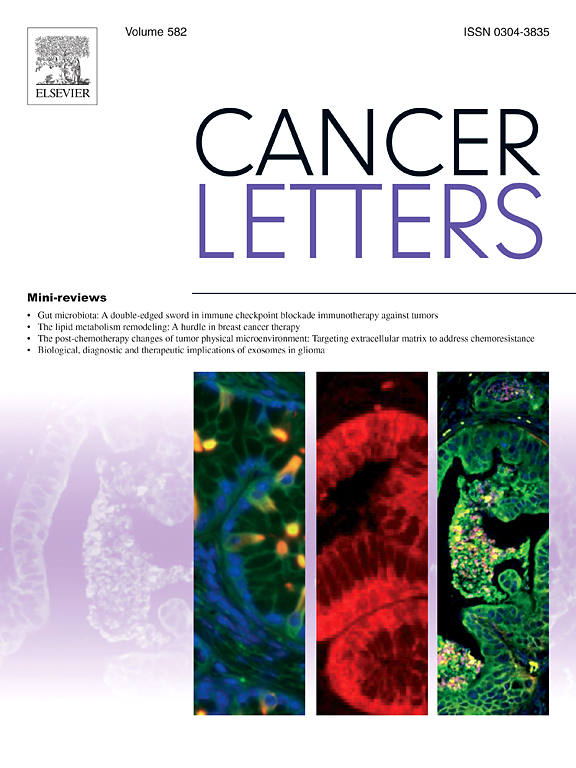激素和神经元的相互作用形成脑转移微环境
IF 9.1
1区 医学
Q1 ONCOLOGY
引用次数: 0
摘要
转移性进展导致大多数癌症相关死亡,中枢神经系统(CNS)的参与对患者和临床医生提出了特别艰巨的挑战。脑转移瘤(BrM)通常起源于肺癌、乳腺癌和黑色素瘤,预后不佳。尽管治疗的进步延长了许多颅外肿瘤的生存期,但BrM的发病率仍在继续攀升,这凸显了在理解肿瘤在中枢神经系统中定植的独特生物学方面的关键知识空白。虽然明确的证据仍然有限,但越来越多的关注癌症神经科学,特别是关于大脑中依赖激素的癌细胞,已经开始揭示通常由性类固醇和神经类固醇调节的因素可能类似地影响中枢神经系统的特化转移微环境。类固醇激素可以穿过血脑屏障(BBB)或由星形胶质细胞和其他中枢神经系统驻留细胞重新合成,可能影响炎症、突触可塑性和免疫监视等过程。然而,这些激素途径是如何被播散性癌细胞所利用的仍不清楚。在这里,我们回顾了成人大脑复杂的激素景观,并研究了通常由性激素调节的神经内分泌-免疫相互作用如何支持转移性生长。我们讨论了全身激素、局部类固醇生成和肿瘤适应之间的相互作用,以确定新的治疗机会。本文章由计算机程序翻译,如有差异,请以英文原文为准。
Hormonal and neuronal interactions shaping the brain metastatic microenvironment
Metastatic progression drives the majority of cancer-related fatalities, and involvement of the central nervous system (CNS) poses especially formidable challenges to patients and clinicians. Brain metastases (BrM), commonly originate from lung, breast and melanoma cancers, and carry disproportionately poor outcomes. Although therapeutic advances have extended survival for many extracranial tumors, BrM incidence continues to climb—underscoring critical knowledge gaps in understanding the unique biology of tumor colonization in the CNS. While definitive evidence remains limited, a growing focus on cancer neuroscience—especially regarding hormone dependent cancer cells in the brain—has begun to reveal that factors normally regulated by sex steroids and neurosteroids may similarly influence the specialized metastatic microenvironment in the CNS. Steroid hormones can permeate the blood-brain barrier (BBB) or be synthesized de novo by astrocytes and other CNS-resident cells, potentially influencing processes such as inflammation, synaptic plasticity, and immune surveillance. However, how these hormonal pathways are co-opted by disseminated cancer cells remains unclear. Here, we review the complex hormonal landscape of the adult brain and examine how neuroendocrine–immune interactions, often regulated by sex hormones, may support metastatic growth. We discuss the interplay between systemic hormones, local steroidogenesis, and tumor adaptation to identify novel therapeutic opportunities.
求助全文
通过发布文献求助,成功后即可免费获取论文全文。
去求助
来源期刊

Cancer letters
医学-肿瘤学
CiteScore
17.70
自引率
2.10%
发文量
427
审稿时长
15 days
期刊介绍:
Cancer Letters is a reputable international journal that serves as a platform for significant and original contributions in cancer research. The journal welcomes both full-length articles and Mini Reviews in the wide-ranging field of basic and translational oncology. Furthermore, it frequently presents Special Issues that shed light on current and topical areas in cancer research.
Cancer Letters is highly interested in various fundamental aspects that can cater to a diverse readership. These areas include the molecular genetics and cell biology of cancer, radiation biology, molecular pathology, hormones and cancer, viral oncology, metastasis, and chemoprevention. The journal actively focuses on experimental therapeutics, particularly the advancement of targeted therapies for personalized cancer medicine, such as metronomic chemotherapy.
By publishing groundbreaking research and promoting advancements in cancer treatments, Cancer Letters aims to actively contribute to the fight against cancer and the improvement of patient outcomes.
 求助内容:
求助内容: 应助结果提醒方式:
应助结果提醒方式:


